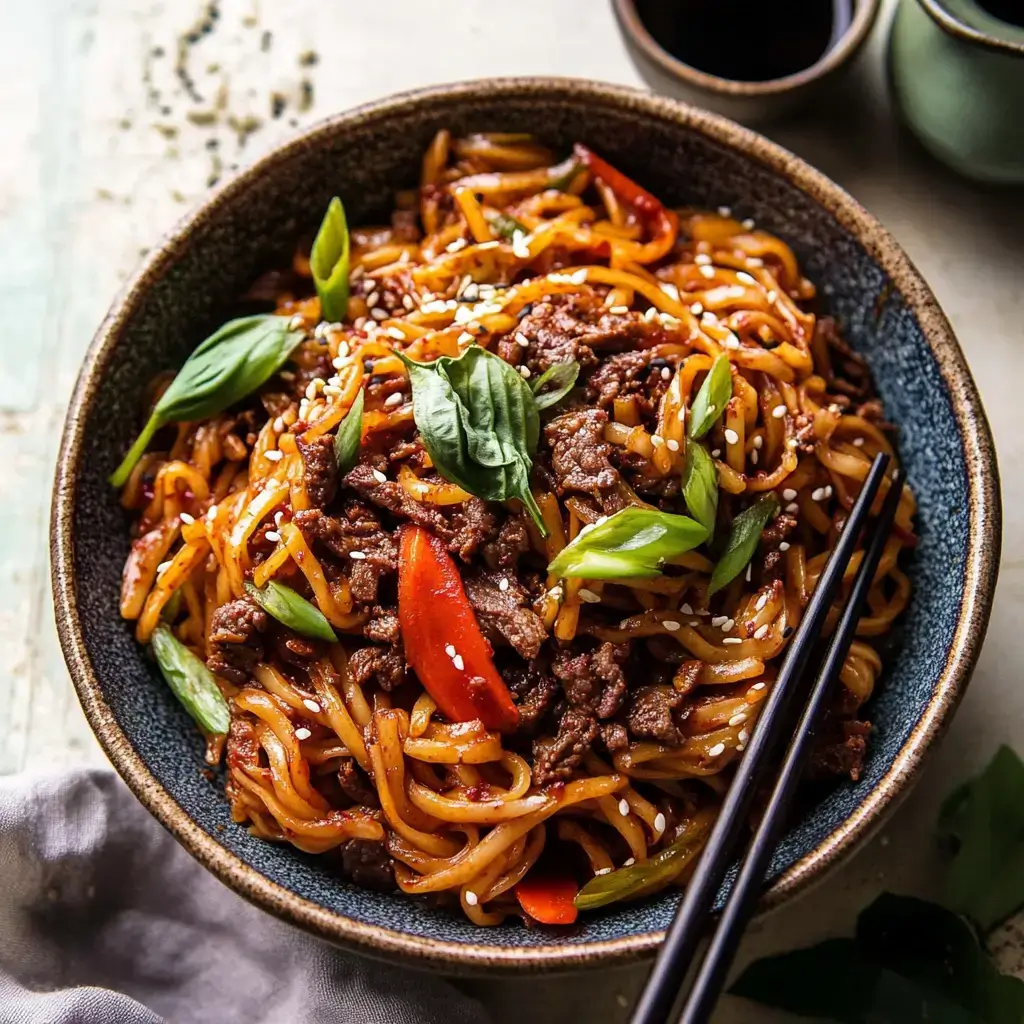Exploring Korean Ground Beef Noodles
Hey there! So, let’s chat about putting together a scrumptious dish known as Korean ground beef noodles. Trust me, the fun of this dish lies in endless possibilities. Get ready to mix and match your way to noodle heaven.
Noodle Choices Galore
Traditionally, you’d use Korean wheat vermicelli noodles like mukluks or somyeon—they’re thin and soak up that beefy sauce like a dream. But hey, rules are made to be broken, right? Maybe you’re feeling egg noodles, or perhaps the curly goodness of ramen gets your heart racing. Don’t forget about rice noodles or even white rice if you’re looking for a twist. Chuck some veggies in there for a dose of healthiness too! Your noodle, your call—noodle-freedom (Kroll’s Korner).
Your Recipe, Your Way
Here’s the beauty of Korean ground beef noodles: you make it your dish. Start with a dreamy Korean beef sauce. Picture this: browned ground beef, onion, garlic, soy sauce, maybe a bit of ginger, and sugar—yum! Beyond Kimchee has a foolproof method: cook onions, garlic, and beef until golden, then jazz it up with soy sauce, water, honey, and ginger. Let it bubble away till it’s finger-lickin’ good.
Let loose your inner chef and tweak the recipe just how you like it. Wanna spice it up? Throw in some chili flakes or hot sauce. Feeling a veggie vibe? Go on, add those greens. This dish is as flexible as a contortionist in a circus. Whatever moves you’re in, Korean beef noodles will shake it along with you.
So, there you have it, a lowdown on digging into the world of Korean ground beef noodles. Play with flavors, experiment with those noodles, and create a meal that’s not just food, but a flavor adventure. Culinarians unite—this is your time to shine!
Flavorful Korean Beef Noodles
Alright folks, let’s chat about my go-to comfort food: Korean beef noodles. There’s something magical about that juicy ground beef swimming in a savory sauce with noodles. Let me give you the scoop on crafting this scrumptious dish.
Essential Ingredients
Here’s what you’re gonna throw in the pot for these noodles. The flavors dance together like nobody’s business:
- Ground Beef: Go for the good stuff. Trust me, it makes a world of a difference.
- Onion: Sweet and savory magic in a bulb.
- Minced Garlic: Gives that beef sauce an umami high-five.
- Soy Sauce: Our salty BFF, giving depth to the whole deal.
- Sugar: A spoonful to keep the soy from being the bossy one.
- Ginger: Warming things up with its spicy personality.
- Water: Keeps the sauce from being a sticky mess, making the noodles happy.
Mix these babies up just right, and you’ve got a sauce that’ll make those noodles sing.
Cooking the Ground Beef
Alrighty, time to get that beef yummy:
- Saute Onion and Garlic: Start off by giving those onions and garlic a spin in the pan until they’re all glistening and smelling heavenly.
- Brown the Ground Beef: Throw in the beef and stir till it browns up nice – wave goodbye to any extra juices.
- Add Seasonings: Once browned, splash in the soy sauce, water, honey, sugar, and a dash of ginger. That’s what makes it sing with that Korean flair.
- Simmer: Let the whole thing sit on low for about 15ish minutes. You’re waiting for those flavors to snuggle up and get the perfect yum factor.
When you’ve followed these steps, the result is a beef sauce so good, it’ll have you doing a happy dance as you mix it with Korean wheat vermicelli noodles. Serve those bad boys topped with some crispy cucumber slices and a few chili slivers for that fresh kick. All this makes one solid dish that’ll hit the spot, whether it’s snowing or shining outside.
Serving Korean Ground Beef Noodles
Ah, Korean beef noodles! It’s not just the delicious noodles themselves that make the meal. Oh no, the extras – those tasty sides and charming garnishes – play a big part too. Toss in a little pizzazz on presentation, and suddenly your meal’s taken on a new level of yumminess. Here’s how you can jazz up your Korean beef noodles with some sides and groovy presentation tips.
Tasty Sides and Garnishes
- Kimchi: You can’t beat a classic. Kimchi, with its spicy zing and tangy pop, pairs like a dream with beef noodles. Plus, it’s got those probiotic perks – like a tasty health bonus.
- Pickled Radishes: These little crunchy, sweet guys are a refreshing bite amid your savory noodle goodness. Think of them as a palate reset.
- Sesame Spinach: A dish so simple, yet so good. It’s got that fresh green vibe with a nutty whisper of sesame – a great partner for those rich noodles.
- Soy Sauce Eggs: Soft-boiled and marinated just right, these eggs bring in that savory, umami oomph. Hello, taste bud party!
- Cucumber Salad: A light, crisp salad with a zesty vinaigrette – perfect for cutting through the richness of your noodles. It’s like a cool breeze on a hot day.
Presentation Tips
- Colorful Dishware: Break out your vivid, eye-catching plates. They make your noodles and sides pop and set the table for a visual feast.
- Garnish with Fresh Herbs: Toss some green onions or cilantro on top for a burst of color and a hint of freshness. It’s the little touches that count.
- Arrange Neatly: Lay those noodles out nice and tidy; give them room to breathe. A neat plate is an inviting plate.
- Use Serving Platters: Set your sides in small bowls or on a big platter for that friendly, share-and-share-alike vibe. Can you say family feast?
- Include Chopsticks: For that authentic flair, slide some chopsticks next to the forks. Eating noodles the traditional way just feels right.
With these tasty pick-me-ups and a few presentation tweaks, your Korean beef noodles will stand out as a feast for the senses. Why stop there? Check out more Mongolian beef recipes for extra meal magic.
Checking Out Korean Noodle Varieties
Korean noodles aren’t just food—they’re a passport to flavor town. Let’s yap about three yummers: Bibim Naengmyeon, Milmyeon, and Japchae.
Bibim Naengmyeon
Bibim Naengmyeon is that cool breeze on a blazing summer day. Cold noodles, spicy gochujang sauce—it’s chill with a twist, like a K-pop jam in food form. Toss on some cucumbers, a sliced boiled egg, crunchy lettuce, cabbage, kimchi, or a few meat slices, and you’re ready to party. This sweet and spicy number, cooled off with the cold noodle dance, is bound to get your taste buds groovin’.
Can’t get enough of Bibim Naengmyeon? Check out more about it—and some other noodley goodness—on our article about Mongolian ground beef noodles.
Milmyeon and Japchae
Straight outta Busan, Milmyeon brings the flavor in two fab styles:
- Mul Milmyeon: Imagine noodles soaking in a clear, refreshing bath. These are made from sweet potato, potato, and flour—just like your favorite comfort food. Light, breezy, and super nourishing.
- Bibim Milmyeon: Say “see ya” to broth and “hello” to spicy, tangy swagger. The mix here is a texture playground, spicy meets daredevil tastes, guaranteed to be a food adventure worth taking.
Then there’s Japchae, the life of any party. These glass noodles, which magically turn see-through when cooked, are all about sweet potato starch pizzazz. Stir-fried with veggies that look like they jumped out of a rainbow, meat, soy sauce, and sesame oil, this one’s packed with flavor like your favorite playlist. Usually enjoyed at room temperature, Japchae makes celebrations feel extra special.
To get the full scoop on these noodles and send your culinary journey soaring, check out our deep-dive into the Mongolian ground beef recipe. Go ahead, explore the quirky, drool-worthy charms of Bibim Naengmyeon, Milmyeon, and Japchae. Your taste buds will thank you!
Trying Different Korean Noodle Dishes
Check out the tasty world of Korean noodles where flavors and textures promise a burst of excitement! Today, we’re diving into Jjajangmyeon and Instant Ramen delights, two dishes that’ll make your taste buds do a happy dance.
Jjajangmyeon Explained
Say hello to Jjajangmyeon, a beloved noodle dish that Korea shares with its Chinese cousin. Imagine thick noodles, slathered with a savory, slightly sweet black bean sauce. This sauce, a soy or oyster sauce blend, comes enriched with chunks of pork, potatoes, onions, and some sneaky vegetables. Sounds like a hug in a bowl, right? It’s known for being wallet-friendly, perfect for those days when you want a satisfying meal without breaking the bank. You’ll find it’s one of Korea’s favorites for a reason! Curious to know what other noodle wonders await? Check out Goseong Guy’s scoop on Korean noodles.
Instant Ramen Favorites
We can’t overlook the powerhouse that is Instant Ramen in Korean cuisine. It’s that quick, no-fuss comfort food that’s loved across the nation. Walk into any convenience store, and it’s a noodles extravaganza with choices galore. Brands like Xin bring flavors that’ll tantalize you, such as “mala tang,” which carries the Szechuan spicy kick. Instant ramen isn’t just fast and delicious; it’s also your go-to on those jam-packed days when time’s not on your side. For a deeper dive into what’s hot on the noodle scene, take a peek at Goseong Guy’s latest on Korean noodles.
Whether you’re yearning for the hearty delight that is Jjajangmyeon or the convenient yumminess of instant ramen, these Korean noodle dishes are your ticket to a satisfying flavor journey. They’re the kind of meals that once you taste, keep you coming back, eagerly anticipating the next bowlful of goodness.
Making Savory Kalguksu Noodles
Ah, Kalguksu – the noodle soup that feels like a warm hug in a bowl. This Korean classic is a delight for anyone who loves food with heart and soul. Let’s walk through crafting this comforting dish together.
Traditional Korean Noodle Soup
Kalguksu, or Korean Knife Cut Noodle Soup, has its roots stretching all the way back to the Goryeo era. It’s a cozy delight that folks adore for its straightforward yet utterly comforting flavors. The noodles are hand-cut, making them the main star, and you can jazz up the soup with fun add-ins like crunchy perilla seed powder and Maesaengyi seaweed, which sounds fancy but is actually just delicious green goodness (Kimchimari).
The magic of this dish is in the broth and the noodles – each one perfectly chewy and ready to soak up all the tasty juices. There’s even a spicy sibling to this dish, called Eolkeunyi, where gochujang and gochukaru team up with an anchovy broth for a flavor explosion.
Handmade Noodle Preparation
Now, making these noodles by hand? It’s a dance between patience and reward. Trust me, it’s worth every minute you spend. Before you know it, you’ll be slurping these noodles like a pro. Let’s get our hands a little floury, shall we?
- Dough Preparation: Start with a simple mix of flour and water, usually hitting around a 3:1 ratio. I sometimes whip it up the night before, so it’s ready to go when the noodle craving strikes. Got extra dough? Dry it out, toss it with a bit of flour, and store it for another time (Kimchimari).
- Noodle Crafting: Channel your inner pasta chef with nothing more than your hands, a rolling pin, and a knife. Roll the dough out into thin sheets and slice them into lovely, long strips – the kind that gives this soup its distinct feel.
- Cooking: Those noodles are now ready to dive into a pot of hot broth. Cook ’em till they’re soft yet still got that chewy bounce. They’ll soak up the broth, turning every bite into a delightful fusion of flavors and textures.
Making Kalguksu from scratch lets you taste the love and work you’ve poured into it, spoonful by spoonful. Each slurp feels like an achievement, sealing your home-cooked Kalguksu as a real masterpiece of flavor and tradition. Enjoy!

